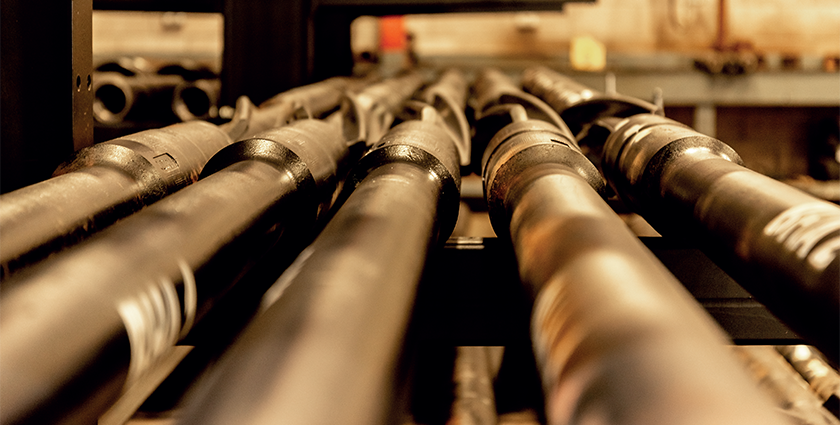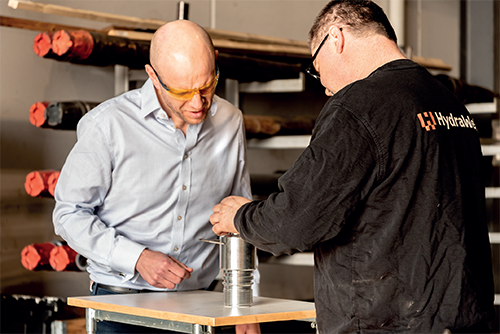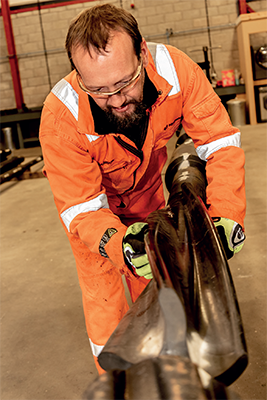
HydraWell
A job well done
Since 2008, HydraWell has been using its innovative PWC technology to provide effective well barrier solutions to clients across the world
Fourteen years ago, the founders of HydraWell recognized a gap in the well integrity market. Traditional methods of well abandonment and barrier assertion continued to prove themselves inefficient, and HydraWell was determined to find a safer, slicker and faster alternative. Through relentless engineering and innovation efforts, the company was able to develop the Perforate, Wash and
Cement (PWC®) system. PWC® is an effective new way of working that cuts down on costs and carbon emissions, whilst remaining fully adaptable to a range of inland and offshore applications. As it continues to pioneer this boundary-defying technology, HydraWell enjoys organic growth, and ongoing global expansion.
 Originally established in Norway, HydraWell was set up in order to provide specialist development services for new downhole systems and tools. The company’s primary goal was to develop an alternative to traditional methods, as Chief Commercial Officer, Tom Leeson, comments: “After HydraWell was incorporated in 2008, we were faced with the challenge of finding an alternative method that would re-establish annular barriers. Inspired by the limitations of existing section milling technology, our team came up with the concept of Perforate, Wash and Cement, or PWC®. From there, the company developed tooling that would streamline the process of building an annular barrier.
Originally established in Norway, HydraWell was set up in order to provide specialist development services for new downhole systems and tools. The company’s primary goal was to develop an alternative to traditional methods, as Chief Commercial Officer, Tom Leeson, comments: “After HydraWell was incorporated in 2008, we were faced with the challenge of finding an alternative method that would re-establish annular barriers. Inspired by the limitations of existing section milling technology, our team came up with the concept of Perforate, Wash and Cement, or PWC®. From there, the company developed tooling that would streamline the process of building an annular barrier.
“With PWC® technology, it is possible to save over a million dollars in materials and services. Since its creation, HydraWell has worked closely with its clients to help them bring new and advanced systems into their existing abandonment strategy. We have faced various challenges, including some resistance to such new and innovative technology from operators and some industry regulators. We continue working to overcome this, by communicating our ideas and getting people comfortable with using the new system, which is backed up by consistent, effective results.”
Taking a dynamic, disruptive approach to the problems they faced, HydraWell’s engineers were able to develop an entirely new, adaptable and unique way of working. The innovation process required significant analytics, and problem-solving aptitude, as Tom details: “To advance beyond traditional methods, we used computational fluid dynamic analysis to be able to predict fluid behaviors downhole, depending on the geometry, flow rates, densities, and viscosities. The end goal is to ‘change out’ fluids, in order to remove contaminants, loose solids and debris, and make all surfaces water-wet. The cementing process then installs a clean barrier across the whole of the wellbore.
“Traditional cementing practices are not always applicable. When trying to cement an annulus by circulating from the base, we often run into the classic problem of seeing a channel on the narrow side of the annulus. The annulus is never symmetrical, and cementing the narrow (or low) side is often problematic. To solve the issue, we went back to the drawing board, rather than trying to force traditional cementing methods to work.
“We began by trying to create as much turbulence as possible. The key is making sure that the turbulence and mixing is forced to take place at every point in the annulus, so there aren’t any dead spots. Continuingly adding fresh cement to this mixing eventually results in good cement being present at every point in the annulus. Of course, there are lots of variables here that can help us tailor the process to the specific job – for example, if the viscosity or perforated casing is changed then we can optimize the method and maximize efficiency. In some instances, the optimization process has enabled us to reduce required flowrates from ten barrels a minute, to less than two-and-a-half barrels per minute. With a lower flow-rate, we can consider using coiled tubing, and move away from running jointed pipe.
“We now have a whole range of jobs that can be completed using a coil, which not only saves rig time, by moving away from section milling to PWC®, but we also have an impact on the client’s cost model and carbon emissions. Without the need for a rig, clients significantly reduce fuel consumption, which in turn reduces the environmental impact of the operation.”
From this initial breakthrough, HydraWell has developed numerous tools to support the PWC® process. “When the company first started out, the first solution it produced was a cup-based PWC® tool, which we called HydraWash®. It works on the basis that you have two opposing cups above and below the circulation point. This allows us to define the circulation route, so that when fluid comes out of the stream between cups it only has one route back to the surface. We can then run the fluid through the perforations in the casing, up the annulus, through a secondary set of perforations and finally the well bore back up to the surface.
“The PWC® system creates a singular flow path, which means we are able to wash the annulus and get cement fluid directly into it during the cementing process. However, this concept only works for relatively straightforward geometries and operating parameters. Once we started working with a significant amount of existing cement in the annulus, we realized how this complicates the circulation path. Unfortunately, it can be very difficult to know whether or not the flow path is viable, so we have to take extreme care throughout the entire operation. It is possible to mitigate the risk of loss of circulation, but it requires the operation to be executed more slowly, negating the time savings that PWC® can deliver.
“Once we recognized this complication, our engineers developed what we call ‘jet-based PWC®’. This system, known as HydraHemera® doesn’t use cups, so when necessary the fluid can bypass an annulus blocked by existing cement. It might seem inefficient but computational fluid dynamic (CFD) analysis, and results in the field, prove otherwise. Drawing on a combination of CFD predictions and operational results, we can use a data-driven approach to evaluate the most cost-effective PWC® for each individual job, considering different variables, including fluid densities and viscosities, to determine how we can effectively use jet and perforation systems without risking the quality of the barrier installed.
“In our current tools we typically have four or six jets, with fluid exiting at around 450 ft a second, which is incredibly powerful. With this energy getting to the annulus, we no longer have dead spots. The effectiveness of our system has been proven time and again, with over 500 jobs being completed with a successful barrier, and zero failures over the last three years.
“We have definitely learned lessons from the early failures we did have. We now understand which wells are suitable for PWC® application and which aren’t, and our advanced screening process is used to make sure we apply the right methods to each individual situation. With such a complex task at hand, there’s no such thing as a ‘one size fits all’ approach. In analyzing our progress over the years, we have been able to replicate positive results time and again. We are often able to repeat or adapt operations used in previously successful jobs for similar structures, and this helps promote the use of our PWC® technique.
“We are always developing our technology. At the moment, we are working on a coiled tubing option called HydraCT®, which has been tested successfully by one of our clients in a simulation well. The results have been positive, and so we are looking forward to using the new tool in the field within the next month or so,” Tom insists.
This amazing aptitude for innovation has helped HydraWell establish itself in a range of different territories, as Tom confirms: “We have recently entered the Brazilian market, and secured a long-term contract there, which is very exciting. Whilst we are preparing for our first job there, we are also completing our first Australian project, and mobilizing for a second one in May. There’s lots of growth in this sector, and we are seeing that on a global scale. There is activity in Australia, but also in South-East Asia, Malaysia and even the Middle East, particularly Qatar, Kuwait and UAE.
“Alongside these developments, we are expanding our already more established operations across Europe. There are a lot of companies in the region that are looking to abandon onshore wells without a rig, which is a little bit more challenging because the unit has limited capability. In those areas we will be mobilizing our new coiled tubing technology, because it offers a really cost-effective, more straight-forward way of safely and securely abandoning those wells. Overall, we have a real focus on geographical expansion at present, and part of that is moving from offshore wells to onshore locations as well. It’s exciting, because there is still so much innovation and growth to come.”
This is clearly just the beginning for HydraWell. As it continues to lead the industry toward new and innovative ways of working, the company also looks to optimize and expand its own portfolio. As Tom reveals: “We are looking to introduce a number of new tools this year, including the HydraCT® and the HydraTyphon®. It’s important that we communicate the effectiveness of these new technologies in order to grow acceptance and increase use within the sector. In turn, we are looking to expand our range of applications, and the variety of problems that can be solved using PWC systems.
“Looking further ahead, I think the challenge for HydraWell will be applying our problem-solving capabilities to new areas, whether they are in abandonment, production or maintenance. In order to expand our portfolio, we are open to continue working closely with other service companies in our sector. A combination of tools, systems and approaches will no doubt advance the technology, and increase our overall efficiency, so that’s something we are looking to invest more time into over the coming years.
“The support of our clients will continue to be vital to the success of HydraWell. There are lots of operators across the industry who are looking to problem solve with us. Together we can pinpoint challenges in regards to emissions, cost, health and safety and even technical risk, so we really enjoy working collaboratively like that. At the end of the day, we all want the best results, and building synergy with others is an effective way of achieving that goal,” he concludes.
HydraWell
www.hydrawell.no
Services: Well engineering services